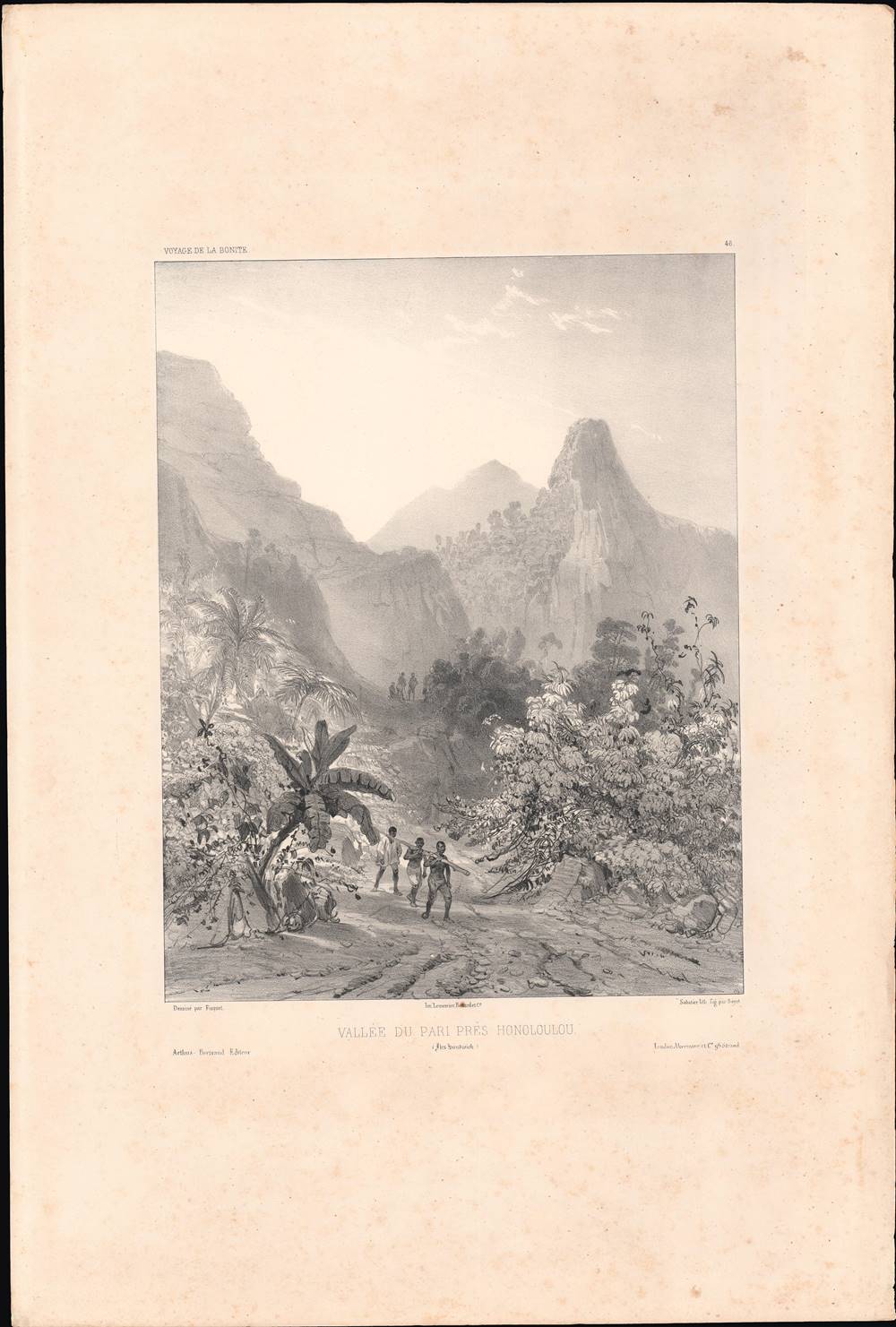1845 Lithograph of Nuʻuanu Pali, Honolulu, Hawaii
HonoluluValley-fisquet-1845
Title
1845 (undated) 12.25 x 9.5 in (31.115 x 24.13 cm)
Description
Nuʻuanu Pali
'Vallée du Pari' in the view's title refers to Nuʻuanu Pali and Nuʻuanu Valley, a historically and culturally important pass through the Koʻolau Mountains near Honolulu. Aside from its significance in folk religion and importance as one of the few passes through the mountains, Nuʻuanu Pali is also where Kamehameha I won a decisive battle in 1795 to unite the Hawaiian Islands under his rule. The first road through the pass was completed the same year that this map was published.The Bonite Expedition
The French ship La Bonite undertook a voyage of scientific and geographic exploration in 1836 - 1837. Led by Auguste-Nicolas Vaillant, the voyage circumnavigated the globe, en route depositing diplomats at various posts. Along the way, important observations were made that contributed to several fields, especially botany and zoology. A large account of the voyage was written upon the ship's return, divided into thematic volumes, including an album of drawings by the ship's artists, Théodore Auguste Fisquet and Barthélémy Lauvergne. The Bonite Expedition was inspired by the voyages of Captain James Cook and visited many of the same sites. Unlike Cook's voyage, the Bonite was particularly fortunate and no sailors in the course of the voyage.Publication History and Census
This view was published as part of the multivolume work Voyage autour du monde exécuté pendant les années 1836 et 1837 sur la corvette La Bonite commandée par M. Vaillant, capitaine de vaisseau, and appears to have been one of the 99 plates included in the Album historique. It was sketched by Théodore Auguste Fisquet, edited by Arthus Bertrand, and printed using a lithograph technique by the firm Lemercier, Benard et Compagnie (more specifically, Adolphe Jean Baptiste Bayot). It was published in London by Akermann and Co. Because of the variety of catalog entries for the Voyage autour du monde and the Album historique, the prevalence of this view is difficult to know with certainty. It is cataloged in the holdings of the National Library of Australia and the Album historique is cataloged in a small handful of libraries in Europe. This view is scarce to the market.CartographerS
Théodore Auguste Fisquet (1813 - 1890) was a French artist and painter and, along with Barthélémy Lauvergne, one of the two artists assigned to the 1836 – 1837 Bonite expedition that circumnavigated the globe. More by this mapmaker...
Rose-Joseph Lemercier (June 29, 1803 - 1887) was a French photographer, lithographer, and printer. One of the most important Parisian lithographers of the 19th century, Lemercier was born in Paris into a family of seventeen children. His father was a basket maker, and he even began working as a basket maker at the age of fifteen, but Lemercier was drawn to lithography and printing and soon entered into an apprenticeship with Langlumé, where he worked from 1822 until 1825. After working for a handful of other printers, Lemercier started his own firm in 1828 at 2, rue Pierre Sarrazin with only one printing press. He subsequently moved a few more times before arriving at 57, rue de Seine, where he founded the printing firm Lemercier and Company. He created the firm Lemercier, Bénard and Company in 1837 with Jean François Bénard. Lemercier bought out Bénard's share in the firm in 1843 and, since his two sons died at a young age, he decided to bring his nephew Alfred into the business beginning in 1862, who would progressively take on more and more responsibility in running the firm. Between 1850 and 1870, Lemercier's firm was the largest lithographic company in Paris. The firm began to decline in prestige in the early 1870s, and, after Lemercier's death in 1887, its descent only quickened. It is unclear when the firm closed, but Alfred directed the firm until his death in 1901. Learn More...
Adolphe Jean Baptiste Bayot (1810 – 1866) was French lithographer who specialized in depictions of battles in various locations throughout the world. Learn More...
Claude Arthus-Bertrand (1769-1840) was a French army officer during the French Revolution. In the Napoleonic era, he founded a firm (Arthus-Bertrand, 1803 – present) that specializes in producing military medals, decorations, and insignia, often for the French government. Arthus-Bertrand was also an enthusiast of scientific expeditions and founded a publisher to promote them, which became the official editor of the Ministère de la Marine in the 1830s, where it oversaw the publication of the accounts of the 1836 – 1837 Bonite expedition that circumnavigated the globe. Learn More...
Ackermann (1795 - 199x) was a British publishing firm founded by Rudolph Ackermann (April 20, 1764 - March 30, 1834). First known as R. Ackermann and Company, Ackermann's three sons took over the business when their father retired. The firm was known as A. Ackermann and Son in the early 20th century and had offices in London, Paris, New York, and Chicago. Their New York office was exceptionally prolific, issuing work for both the private and government sectors. Ackermann was acquired in late 1990s and the imprint resurrected. Learn More...

